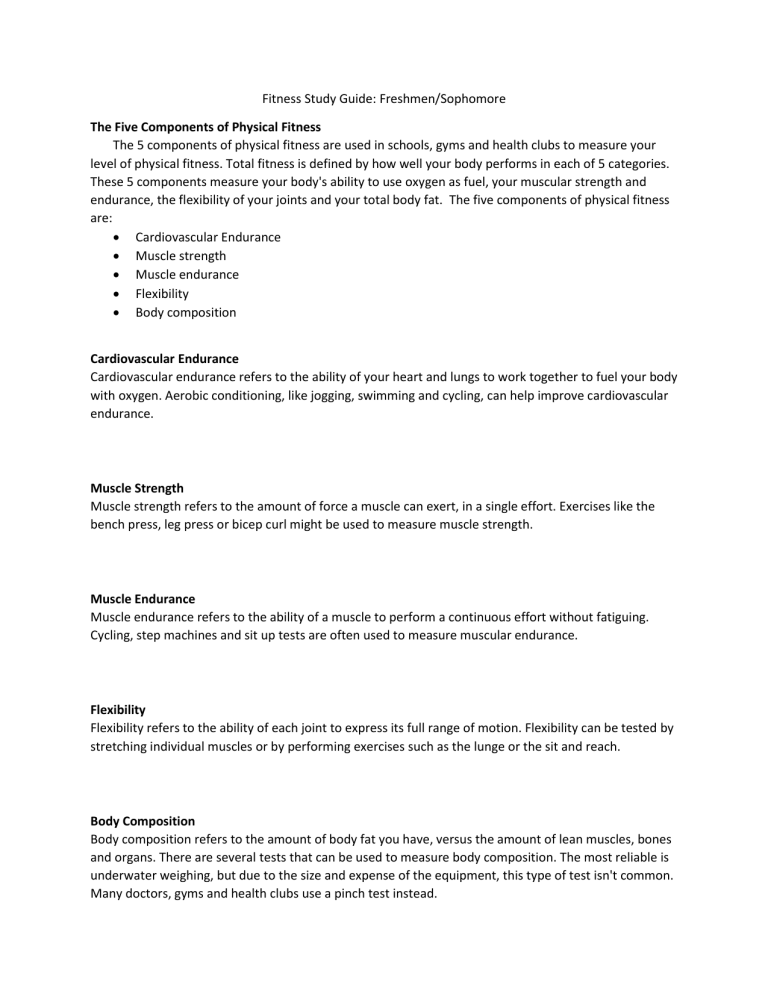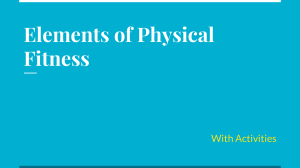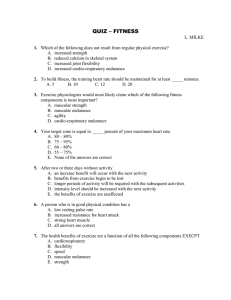
Fitness Study Guide: Freshmen/Sophomore The Five Components of Physical Fitness The 5 components of physical fitness are used in schools, gyms and health clubs to measure your level of physical fitness. Total fitness is defined by how well your body performs in each of 5 categories. These 5 components measure your body's ability to use oxygen as fuel, your muscular strength and endurance, the flexibility of your joints and your total body fat. The five components of physical fitness are: Cardiovascular Endurance Muscle strength Muscle endurance Flexibility Body composition Cardiovascular Endurance Cardiovascular endurance refers to the ability of your heart and lungs to work together to fuel your body with oxygen. Aerobic conditioning, like jogging, swimming and cycling, can help improve cardiovascular endurance. Muscle Strength Muscle strength refers to the amount of force a muscle can exert, in a single effort. Exercises like the bench press, leg press or bicep curl might be used to measure muscle strength. Muscle Endurance Muscle endurance refers to the ability of a muscle to perform a continuous effort without fatiguing. Cycling, step machines and sit up tests are often used to measure muscular endurance. Flexibility Flexibility refers to the ability of each joint to express its full range of motion. Flexibility can be tested by stretching individual muscles or by performing exercises such as the lunge or the sit and reach. Body Composition Body composition refers to the amount of body fat you have, versus the amount of lean muscles, bones and organs. There are several tests that can be used to measure body composition. The most reliable is underwater weighing, but due to the size and expense of the equipment, this type of test isn't common. Many doctors, gyms and health clubs use a pinch test instead. The FITT Principle The F.I.T.T. Principle is one of the foundations of exercise, a set of guidelines that help you set up a workout routine to fit your goals and fitness level while helping you get the most out of your exercise program. F.I.T.T. stands for: Frequency Intensity Time Type The FITT Principle describes how to safely apply the principles of overload, progression and specificity: Frequency Frequency is how often a person performs the targeted health-related physical activity. For each component of health-related fitness, a safe frequency is three to five times a week. Ex: Engaging in a jogging program four times a week or lifting weights 3 times a week. Intensity Intensity is how hard a person exercises during a physical activity period. Intensity can be measured in different ways, depending on which health-related component you are focusing on. Ex: Monitoring heart rate is one way to gauge intensity during aerobic endurance activities, but gives no indication of intensity during flexibility activities. Time Time is the length of the physical activity. As with the other aspects of the FITT principle, time varies depending on the health-related fitness component targeted. Ex: Flexibility or stretching may take 10-30 seconds for each stretch, while the minimum time for performing aerobic activity is 20 minutes of continuous activity. Type Type or specificity, refers to the specific physical activity chosen to improve a component of health-related fitness. Ex: An individual wishing to increase arm strength must exercise the triceps and biceps, while an individual wishing to increase aerobic endurance needs to jog, run, swim or perform some other aerobically challenging activity. Muscular Strength & Muscular Endurance Muscular Strength: The ability of a muscle, or a group of muscles, to exert force for a single maximum effort. My Goal is to Build Muscular Strength (bulking up): o Basic Principle is to use heavy weights and low repetitions 3 sets on each muscular group 2 - 6 reps in each set Heavy weights (85-90 % of 1 rep max) Muscular Endurance: The ability of a muscle, or a group of muscles, to sustain repeated contractions over longer period of time. My Goal is to Build Muscular Endurance (Toning) o Basic Principle is to use light weight and high repetitions 3 sets on each muscle group (possibly more) 12-15 repetitions for each set Lighter weight (70% or less of 1 rep max) My Goal is to Build Both Muscular Strength & Endurance: o Basic Principle is to use moderate weight and moderate repetitions 3 sets on each muscular group Between 8-12 reps for each set Moderate weight (70 - 85% of 1rep max) Health Related Fitness Cardiorespiratory Endurance: The ability of the cardiovascular system (heart, blood and blood vessels) and the respiratory system (lungs and air passages) to deliver oxygen and other nutrients to the working muscles and to remove wastes. Taking your Pulse: Use your index and middle finger (Never the thumb- it has its’ own pulse) Can take your pulse in 2 spots o Neck o Wrist Use a 6 second count and add a 0 (x 10) to your count Maximum Heart Rate: The maximum heart rate is the highest heart rate achieved during maximal exercise o The formula for figuring Maximum Heart Rate: 220 – age = Maximum Heart Rate Target Heart Rate: This is when your exercise heart rate (pulse) is 60-80% of your maximum heart rate. o Calculating your target heart rate: Figure out your Maximum Heart Rate (220 – age = Max Heart Rate) (your max) X .6 (60%) through (your max) X .8 (80%) Example: 220 – 14 = 206 X .6 = 123.6 (round up to 124) 220 – 17 = 203 X .8 = 162.4 (round down to 162) Resting Heart Rate: A normal resting heart rate for adults ranges from 60 to 100 beats a minute. Generally, a lower heart rate at rest implies more efficient heart function and better cardiovascular fitness. o Example, a well-trained athlete might have a normal resting heart rate closer to 40 beats a minute. o Best to take it right after you wake up/well rested


